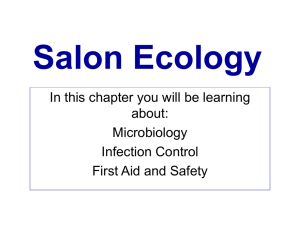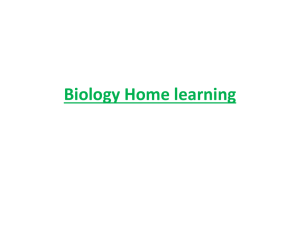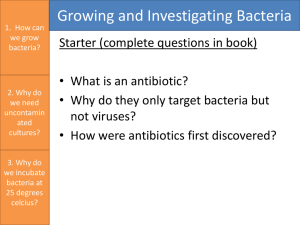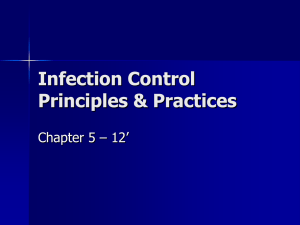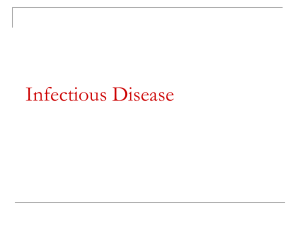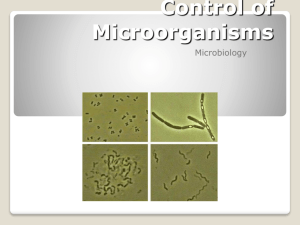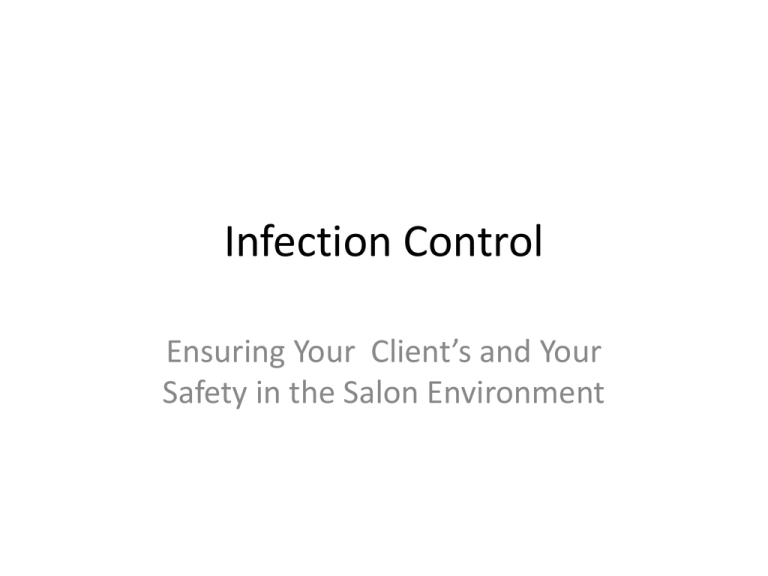
Infection Control
Ensuring Your Client’s and Your
Safety in the Salon Environment
Bacteria
• One-celled
microorganisms (germs,
microbes)
• Abundantly present
everywhere
– Skin, water, air, decayed
matter
– Nonpathogenic-helpful
bacteria
– Pathogenic –harmful
bacteria
Classifications of Pathogenic Bacteria
• Cocci- round shaped,
appear singly or in groups
– Staphylococci-pus- forming
grow in clusters (abscesses,
pustules and boils)
– Streptococci-pus-forming,
grow in chains(strep
throat, blood poisoning)
– Diplococci-grow in pairs
(pneumonia
Classifications of Pathogenic Bacteria
• Bacilli- short, rodshaped bacteria
(lockjaw, typhoid fever
and tuberculosis)
• Spirilla- spiral or
corkscrew shaped
(syphillis or Lyme
disease
Movement of Bacteria
Cocci-transmitted in air, dust or within substance on which they settle.
Bacilli and spirilla are motile and have slender, hair-like extensions known
as flagella or cilia for locomotion.
Growth and Reproduction
Active Stage-grow and reproduce-warm, dark,
damp places-sufficient food available
Divide into two new cells – mitosis
Inactive (spore forming stage)-form spherical
spores with tough outer covering for
protection-cannot be harmed by disinfectants
When conditions are favorable they grow and
reproduce.
MITOSIS
Bacterial Infections
• When body tissues are
invaded by pathogenic
bacteria.
• Local infection- pimple
or abscess
• General infectioncarried by bloodstream
to all parts of the body.
Bacterial Infections
• Contagious spread
–Unclean hands,
implements or
towels,
uncovered
coughing or
sneezing
Viruses
submicroscopic –capable of infesting almost all plants
and animals- live by penetrating cells and becoming a
part of them.
Hepatitis Virus
Hepatitis A-3 weeks –vaccine available, Hepatitis B
long term cirrhosis, vaccine available, Hepatitis C-no
vaccine available
HIV/AIDS
Human Immunodeficiency Virus-Acquired Immune
Deficiency Syndrome
How Pathogens Enter the Body
•
•
•
•
•
Break in the skin
Mouth
Nose
Eye or ears
Unprotected sex
Principles of Prevention
• Decontaminationremoval of
pathogens from
tools and surfaces
by physical or
chemical means.
• 3 levels of
decontamination
Sterilization
• Highest level of
decontamination
• Completely destroys
every organism.
• Methods include steam
autoclave and dry heat
Disinfection
• Controls
microorganisms on
nonporous surfaces.
Does not kill
bacterial spores.
Disinfectants
• Disinfectants chemical
agents used to destroy
most bacteria and
viruses.
• Disinfectants are not for
use on human skin, hair
or nails.
Disinfectants
• Quats-quaternary
ammonium
compounds-–non-toxic,
fast acting
• Phenols-not
recommended for
rubber and plastic items
• Alcohol -70% (ethyl,
99% for Isopropyl
• Bleach
Disinfecting
Implements
Pre-clean implements &
tools.
Rinse thoroughly
Put on gloves and safety
goggles
Mix solution according to
manufacturers directions
Immerse tools or
implements required time
Remove implements
Rinse and dry thoroughly
Store in clean, closed dry
disinfected container.
Requirement For ALL
Students concerning dirty
implements.
Every student must have at
their station the following:
Zip lock baggie marked “presanitized implements” for
their clean combs and
brushes.
Zip lock baggie marked “soiled
implements”.
Make sure each student
cleans dirty combs and
brushed with hot water and
soap, the place in wet
sanitizer.
Station inspections will be
performed regularly without
prior notice.
Blood Spill Disinfection
• Stop service and clean
injured area.
• Use gloves or finger
guard
• Apply antiseptic
• Cover injury with bandaid or other dressing
• Clean workstation
• Discard contaminated
objects
• Double-bag, use
biohazard sticker
• Remove gloves, wash
hands with soap and
water
• Disinfect contaminated
items by full immersion
in EPA-hospital grade
disinfectant
Sanitation
• “To significantly reduce
the number of
pathogens or disease
producing organisms
found on a surface”
• Proper washing of
hands before and after
each client.
Your Professional Responsibility
• Protect you client’s
health and safety as
well as your own.
• Never take shortcuts
with sanitation and
disinfection.
• Follow the rules of
safety and sanitation
always.
SANITATION IS EVERYONE’S
RESPONSIBILITY
• THE BUCK STOPS
HERE!!
• INSTRUCTORS,
STUDENTS, STAFF
AND
ADMINISTRATORS
Assignment
1. Complete the
Infection Control
Pyramid in your
Study Guide
2. Complete the
Brain Conditioner
section






